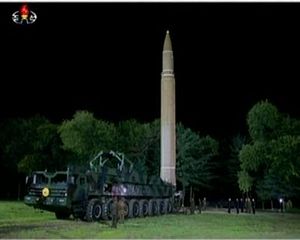North Korea has fired a ballistic missile from a test site north of the North Korean capital Pyongyang at around 1:17 p.m. EST today, according to the South Korean military.
“North Korea launched an unidentified ballistic missile into the East Sea from the vicinity of Pyongsong, South Pyongan Province, at around 3:17 a.m. today,” the Republic of Korea (ROK) Armed Forces Joint Chiefs of Staff (JCS) said in a statement.
It was the first time in 74 days that North Korea conducted a ballistic missile test and the 20th North Korean missile test in 2017. The launch took place during the night, likely meant to simulate operational use.
According to the U.S. Department of Defense (DoD), an initial assessment indicates that the missile was an intercontinental ballistic missile. “The missile was launched from Sain Ni, North Korea, and traveled about 1000 km before splashing down in the Sea of Japan, within Japan’s Exclusive Economic Zone (EEZ),” the statement reads.
“We are working with our interagency partners on a more detailed assessment of the launch. The North American Aerospace Defense Command (NORAD) determined the missile launch from North Korea did not pose a threat to North America, our territories or our allies.”
The South Korean government reports that the missile reached an apogee of 4,500 km (2,796 miles), which would make it North Korea’s highest ballistic missile test to date. An estimate by the Union of Concerned Scientists put the flight time at 54 minutes. North Korea demonstrated a range of 1,000 km, a 3,700 km apogee and a flight time of 47 minutes during its last test of the Hwasong-14/KN20 ICBM at the end of July.
The missile was reportedly fired at a lofted trajectory. According to David Wright at the Union of Concerned Scientists, the missile’s maximum range is estimated at around 13,000 kilometers, which would put the East Coast of the United States well in range. (The distance from the alleged test site to New York is around 10,900 kilometers; to Washington D.C. it is a little over 11,000 kilometers.)
As my colleague Ankit Panda indicated in a previous post, it remains unclear if North Korea achieved the longer range by using a different second stage motor configuration or by increasing the burn time of the engines. However, it is very likely that the missile carried a light mock warhead. “If true, that means it would not be capable of carrying a nuclear warhead to this long distance, since such a warhead would be much heavier,” Wright notes.
The ROK military conducted a “precision strike” missile launch in response to test, according to the JCS. “Our military is keeping an eye on North Korea’s military activities 24 hours. It shows our resolve and ability to strike the origin of provocation and core facilities with precision anytime on the ground, at sea and in the air,” the JCS said in a statement.

































